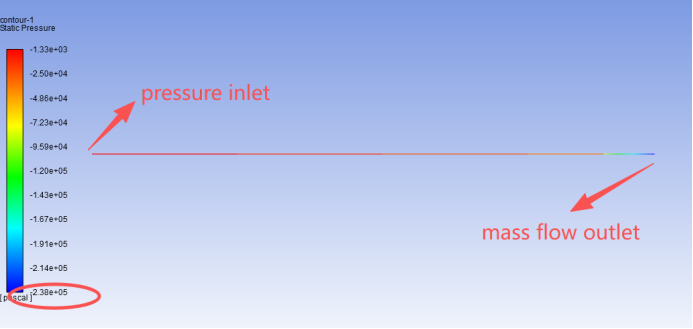-
-
November 14, 2025 at 2:03 am
617283443
SubscriberHi experts!
My simulation subject is a slender pipe containing air as the working medium. The objective is to calculate the pressure drop generated during the air extraction process within the pipe. The operating pressure is set at 101,325 Pa. The inlet boundary condition is set as a pressure inlet (Gauge Total Pressure = 0), while the outlet is configured as a mass flow rate outlet (Mass Flow Rate = 0.0004 kg/s). The calculation results demonstrate excellent convergence with minimal residuals, mass conservation at both inlets and outlets, and stable monitoring metrics. However, the flow field is unreasonable. The issues are as follows:
1.My simulation results indicate a minimum static pressure of -2.38 ×10⁵ Pa and a minimum absolute pressure of -2.21 ×10⁵ Pa. This is clearly unreasonable, as the theoretical limit for static pressure is -101,325 Pa, and absolute pressure should theoretically be greater than zero. The inconsistency is readily apparent from my contour plots. What could be causing this?
2.In the Fluent ‘Solution limits’ window, the default value for ‘Minimum Absolute Pressure (pascal)’ is 1. Why does my calculation still yield a minimum absolute pressure of -2.21e+05 Pa? Are the solution limits not functioning?

-
November 14, 2025 at 7:22 am
Essence
Ansys EmployeeHello,
Please recheck your boundary conditions. They may have been applied incorrectly. Please check the quality of the mesh too.
-
November 14, 2025 at 8:44 am
617283443
SubscriberThank you very much for your reply!I employed a two-dimensional axisymmetric model with a hexahedral mesh, and the mesh quality is excellent! The pipe inlet faces the atmosphere, while the outlet connects to a vacuum pump. What issues might arise with the boundary conditions?
-
-
November 14, 2025 at 10:05 am
Essence
Ansys EmployeePlease check the y+ values, growth rate in your entire domain.
Due to unphysical/unrealistic boundary conditions, you will encounter such negative pressures. In a 2D axisymmetric simulation, the total mass flow rate—as it would be in a 3D case—must be entered. It should not be divided by 2π. Fluent automatically incorporates the axisymmetric revolution when calculating areas and volumes.
If the mass flow is incorrectly specified per radian (i.e., divided by 2π), the inlet velocity and total flow will be underestimated, resulting in inaccurate simulation results.
-
November 14, 2025 at 10:32 am
617283443
SubscriberThank you very much for your reply!You mean that the mass flow rate is too high, causing excessive pressure drop and thus producing this non-physical result?There is no place in Fluent where suppression is applied, such as in the Solution limits?In the Fluent ‘Solution limits’ window, the default value for “Minimum Absolute Pressure (pascal)” is “1”. Why does my calculation still yield a minimum absolute pressure of -2.21e+05 Pa? Are the solution limits not functioning?
-
-
November 14, 2025 at 12:15 pm
Essence
Ansys EmployeeYes, I don't exactly mean that mass flow rate is high. It can be incorrect. Can you share the absolute pressure contour plots?
-
November 14, 2025 at 2:13 pm
-
-
November 14, 2025 at 4:36 pm
Essence
Ansys EmployeeThere are several reasons why solution limits might not be working in your simulation. In Ansys Fluent, if the flow is incompressible, the pressure limiter is ignored because it is designed for compressible flows to prevent negative density values. Additionally, even if the flow is compressible, the pressure limiter is a numerical device that might fail if the numerics are unstable or if the mesh has cells with low orthogonality.
Solution limits in Ansys Fluent may not work if the solver fails to converge due to poor mesh quality, inappropriate boundary conditions, or if the physical model does not accurately represent the real-world scenario. These limits are tied to convergence criteria and numerical stability.
-
- You must be logged in to reply to this topic.


- air flow in and out of computer case
- Varying Bond model parameters to mimic soil particle cohesion/stiction
- Eroded Mass due to Erosion of Soil Particles by Fluids
- I am doing a corona simulation. But particles are not spreading.
- Centrifugal Fan Analysis for Determination of Characteristic Curve
- Issue to compile a UDF in ANSYS Fluent
- Guidance needed for Conjugate Heat Transfer Analysis for a 3s3p Li-ion Battery
- JACOBI Convergence Issue in ANSYS AQWA
- affinity not set
- Resuming SAG Mill Simulation with New Particle Batch in Rocky

-
4212
-
1493
-
1375
-
1197
-
1021

© 2025 Copyright ANSYS, Inc. All rights reserved.











